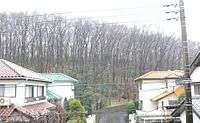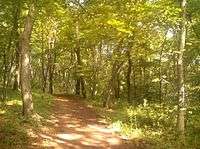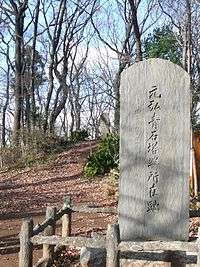Hachikokuyama
Hachikokuyama (東京都立八国山緑地, Tokyo tōritsu Hachikokuyama Ryōkuchi) is a ridge and park in Higashimurayama, Tokyo along its border with Tokorozawa, Saitama. Its name translates literally into English as "Eight Country Mountain" since in times past, one could view the eight surrounding provinces surrounding Musashi Province from its top. In Japanese it is known as a ryokuchi (緑地) instead of a park. Ryokuchi literally means "green land" and denotes land used more as a natural setting instead of a typical park.


The park lies upon a low rising ridge rising about 15 to 20 meters above the surrounding plain. The highest elevation is about 100 meters above sea level. Measured from north to south, the park is from 100 to 300 meters, the park having an uneven size. From east to west the park is about 1.5 kilometers. The trail that runs the length of the ridge top is about 2.0 kilometers and branches into many secondary trails. The total size of the park of is about 39 hectares or about 96 acres.
Historical significance

The park contains an archaeological site, the Shimoyakebe Site (下宅部遺跡) dating from the Jōmon period with the remnants of irrigation and waterworks from the Jōmon through Muromachi periods. Numerous Sue ware pottery fragments have been found in the area.
The route of the ancient Tōsandō highway passed through what is now this park. In the year 1333, Nitta Yoshisada established a campaign headquarters and raised his army's banner on a mound in what is now part of the park during the Kōzuke-Musashi Campaign against the Kamakura shogunate. This mound was either an ancient kofun burial mound or a Fujizuka mounded dedicated to the worship of Mount Fuji, but is now known as the Shogunzuka (将軍塚). This location is commemorated by a stone marker at the park's north eastern end.
Admission to the park is free of charge; however, its is closed on Mondays and Tuesdays.
Hachikokuyama in popular culture
It is famous for being an inspiration for parts of the anime film My Neighbor Totoro.
External links
- More information about the park (Japanese)